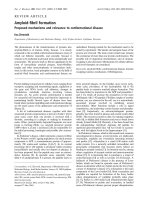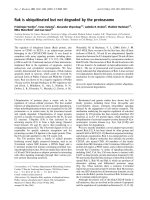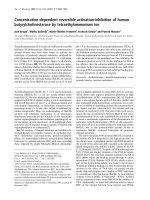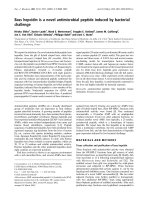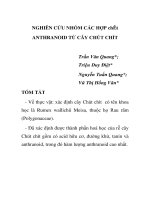Báo cáo y học: " Free cortisol levels should not be used to determine adrenal responsiveness" pptx
Bạn đang xem bản rút gọn của tài liệu. Xem và tải ngay bản đầy đủ của tài liệu tại đây (61.64 KB, 2 trang )
Available online at
Evidence-Based Medicine Journal Club
EBM Journal Club Section Editor: Eric B. Milbrandt, MD, MPH
Journal club critique
Free cortisol levels should not be used to determine adrenal
responsiveness
Aditya Dubey
1
and Arthur J. Boujoukos
2
1
Clinical Fellow, Department of Critical Care Medicine, University of Pittsburgh School of Medicine, Pittsburgh, Pennsylvania, USA
2
Associate Professor, Department of Critical Care Medicine, University of Pittsburgh School of Medicine, Pittsburgh, Pennsylvania, USA
Published online: 13 December 2004
This article is online at
© 2004 BioMed Central Ltd
Critical Care 2004, 9: E2 (DOI 10.1186/cc3040)
Expanded Abstract
Citation
Hamrahian AH, Oseni TS, Arafah BM: Measurements of
serum free cortisol in critically ill patients. NEJM 2004,
350:1629-1638.
1
Background
Because more than 90 percent of circulating cortisol in
human serum is protein-bound, changes in binding proteins
can alter measured serum total cortisol concentrations
without influencing free concentrations of this hormone.
Hypotheses
Patients with presumably normal adrenal function but
decreased cortisol-binding proteins will have lower-than-
expected concentrations of serum total cortisol but
appropriately elevated free cortisol levels.
Measurement of serum free cortisol concentrations will
identify patients with normal or even increased adrenal
function, who, on the basis of low total cortisol
concentrations, would otherwise have been incorrectly
considered to have adrenal insufficiency.
Methods
Setting: Medical, surgical, and cardiac ICUs and general
medical ward of a tertiary care U.S. academic medical
center.
Patients and Measurements: Baseline serum total cortisol,
cosyntropin-stimulated
serum total cortisol, aldosterone, and
free cortisol concentrations
were measured in 66 critically ill
patients with an APACHE score of 15 or higher, 33 healthy
volunteers, and 7 patients with adrenal insufficiency
secondary to hypopituitarism. Patients were further divided
into two groups based on their serum albumin
concentrations of ≤ 2.5 g/dL (low albumin group, n=36) or
>2.5 g/dL (normal albumin group, n=30).
Results
Baseline and cosyntropin-stimulated serum total cortisol
concentrations were significantly lower in the low albumin
group than the normal albumin group. However, serum
free
cortisol concentrations were similar in the two groups and
were several times higher than the values in healthy
controls. Fourteen of thirty-six (39%) low albumin patients
had subnormal cosyntropin stimulated total cortisol
concentrations, consistent with a traditional diagnosis of
adrenal insufficiency. These same patients had high-normal
or elevated serum free cortisol concentrations.
Conclusion
Nearly 40 percent of critically ill patients with
hypoproteinemia had subnormal serum total cortisol
concentrations,
even though their adrenal function was
normal. Measuring serum
free cortisol concentrations in
critically ill patients with
hypoproteinemia may help prevent
the unnecessary use of glucocorticoid
therapy.
Commentary
The incidence of “adrenal insufficiency” in sepsis and septic
shock is believed to be between 30 to 70%. Adrenal
insufficiency is frequently characterized clinically as
hypotension resistant to volume resuscitation and
dependent on vasopressors. Two studies in the 1990’s
showed that the use of stress doses of hydrocortisone
decreased the duration of vasopressor therapy and
improved shock reversal.
2,3
In 2002, a large multicenter,
randomized, placebo controlled trial demonstrated that
steroids improved mortality in patients with septic shock
who had relative adrenal insufficiency, defined as an
Critical Care December 2004 Vol 9 No 1 Dubey and Boujoukos
increase in total cortisol ≤ 9 µg/dL in response to a 250 µg
cosyntropin stimulation test.
4
This has formed the basis for
the current practice of treating patients with septic shock
and adrenal insufficiency with stress doses of steroids.
However, there is controversy about the best indicator of
adrenal insufficiency in the critically ill patients. Several
criteria have been suggested, including, total cortisol ≤
18µg/dL or change in total cortisol ≤ 9 µg/dL in response to
cosyntropin stimulation test, and total random cortisol level
≤ 25 µg/dL.
Free cortisol is the physiologically active form of the
hormone. In a healthy person, 10% of the cortisol is present
in the free form, 20% is bound to albumin, and 70% is
bound to cortisol binding globulin. Earlier studies have
demonstrated that after a stressor like surgery, the
concentration of cortisol binding globulin decreases by 50%,
total cortisol levels increase by 55-100%.
5,6
However,
surrogate markers of free cortisol, such as the free cortisol
index (FCI), and calculated free cortisol levels increase by
130 to 600%. Importantly, these methods of free cortisol
determination do not take into account the changes in
serum albumin levels that occur in critical illness.
The current study by Hamrahian et al. demonstrates
significant variability in serum total cortisol levels in the
presence of hypoproteinemia. It shows that up to 39% of
patients with low albumin levels would be misdiagnosed as
being adrenally insufficient based on total cortisol levels.
Levels in these patients appear to be low due to
hypoproteinemia. Their free cortisol levels seem to be
preserved and may in fact be elevated.
There are several important limitations of this study that
deserve consideration. This study included 18 patients with
sepsis but none with septic shock or multi-organ
dysfunction; i.e., the patients most likely to benefit from
corticosteroid administration were excluded. Because of this
omission, it is difficult to know how to apply the present
findings to this clinically important group. Furthermore, the
physiological status of study patients at the time of cortisol
measurements was not well defined, which makes it difficult
to determine how free cortisol levels equate with other
clinical parameters. Additionally, the technique for
measuring free cortisol is difficult and expensive and not
widely available. Finally, no standard levels of free cortisol
have been reported, so the definition of abnormal for this
parameter remains uncertain.
Like many studies, this one raises a number of interesting
questions. First, what is the true incidence of adrenal
insufficiency in the critically ill? Second, if we are not
measuring and treating true adrenal insufficiency in septic
hypoproteinemic patients, then what are we treating? Third,
how does one reconcile the mortality benefit seen in the
study by Annane and colleagues,
4
which used change in
total cortisol to discriminate responders from non-
responders? Finally, does free cortisol really matter?
CORTICUS, an ongoing 800-patient multicenter trial, should
help
to answer these important questions. CORTICUS will
test the hypothesis that low dose steroids improves 28-day
mortality in patients with septic shock whose cortisol levels
do not increase by more than 9 µg/dL in response to
corticotropin stimulation.
7
In addition, the investigators will
compare total and free cortisol levels in these patients.
Recommendation
Until CORTICUS is completed, we recommend that a) all
patients in septic shock with ≤ 9 µg/dL total cortisol
response to corticotropin stimulation receive low-dose
corticosteroids, and b) free cortisol levels should not be
used to determine adrenal responsiveness.
Competing interests
The authors declare that they have no competing interests.
References
1. Hamrahian AH, Oseni TS, Arafah BM: Measurements
of serum free cortisol in critically ill patients. NEJM
2004, 350:1629-1638.
2. Bollaert PE, Charpentier C, Levy B, Debouverie M,
Audibert G, Larcan A: Reversal of late septic shock
with supraphysiologic doses of hydrocortisone. Crit
Care Med 1998, 26:645-650.
3. Briegel J, Forst H, Haller M, Schelling G, Kilger E,
Kuprat G, Hemmer B, Hummel T, Lenhart A, Heyduck
M, Stoll C, Peter K: Stress doses of hydrocortisone
reverse hyperdynamic septic shock: a prospective,
randomized, double-blind, single-center study. Crit
Care Med 1999, 27:723-732.
4. Annane D, Sebille V, Charpentier C, Bollaert PE,
Francois B, Korach JM, Capellier G, Cohen Y, Azoulay
E, Troche G, Chaumet-Riffaut P, Bellissant E: Effect of
treatment with low doses of hydrocortisone and
fludrocortisone on mortality in patients with septic
shock. JAMA 2002, 288:862-871.
5. le Roux CW, Chapman GA, Kong WM, Dhillo WS,
Jones J, Alaghband-Zadeh J: Free cortisol index is
better than serum total cortisol in determining
hypothalamic-pituitary-adrenal status in patients. J Clin
Endo 2003, 88:2045-2048.
6. Vogeser M, Felbinger TW, Kilger E, Roll W,
Fraunberger P, Jacob K: Corticosteroid-binding
globulin and free cortisol in the early postoperative
period after cardiac surgery. Clin Biochem 1999,
32:213-216.
7. Annane D, Briegel J, Sprung CL: Corticosteroid
insufficiency in acutely ill patients [Letter]. N Engl J
Med. 2003, 348:2157-2159.
2



